Tin
Appearance
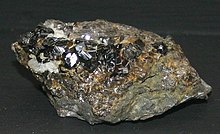
Tin is a chemical element with symbol Sn (for Latin: stannum) and atomic number 50. It is a main group metal in group 14 of the periodic table. Tin shows chemical similarity to both neighboring group-14 elements, germanium and lead, and has two possible oxidation states, +2 and the slightly more stable +4. Tin is the 49th most abundant element and has, with 10 stable isotopes, the largest number of stable isotopes in the periodic table. Tin is obtained chiefly from the mineral cassiterite, where it occurs as tin dioxide, SnO2.
Quotes
[edit]- Quotes are arranged alphabetically by author
A - F
[edit]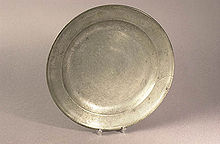

- Because she lately nimm'd some tin, they have sent her to lodge at the King's Head Inn.
- In clear dry air tin retains a bright appearance for many days. According to studies light dulling was noted after 100 days , and faint yellowish grey tarnish colour after 150 days. When tine is washed with soap and water its reflectivity does not change over long periods.
- Bruce D. Craig, David S. Anderson in: Handbook of Corrosion Data, ASM International, 31 December 1994.
- Tin Printing, which was introduced about 1875, is the application of the lithographic process to the decoration of metal plate. A substantial percentage of can-label work formerly done by the paper lithographer has in recent years gone to the tin lithographers... Sheets of prepared tin are fed into the press and are then oven dried at high temperature, this procedure being repeated for each additional colour.
- Harry S. Ashmore in: Encyclopaedia Britannica: a new survey of universal knowledge, Volume 14, Encyclopaedia Britannica, 1961, p. 214.
- Tin derives its name from the anglo-saxon word ´tin´. It derives its chemical symbol ´Sn´ from the latin word stannum. The first uses of tin appear to have been in alloys with copper and zinc to make brass and bronze, and can be dated back to about 3,500 BC. It is not known who identified tin as an element and it may have been recognized as something that could not be divided any further, or was elemental, by alchemists and experimenters.
- Avalon in: Tin, avalonraremetals.com.
- Pweter is an alloy which has 90% tin, 1 to 8% Sb, 0.25 to 5% cu, and a maximum of 0.05 percent Pb and As and it has the same degree of corrosion resistance as pure tin. Alloys within this range are used for decorative items, containers, and flatware.
- Bruce D. Craig, David S. Anderson in:"Handbook of Corrosion Data".
- In Soft Soft solders with small additions of lead in tin impairs the retention of its bright reflective surface in common atmospheres.
- Bruce D. Craig, David S. Anderson in:"Handbook of Corrosion Data".
- The big one I missed out on was 'Cat on a Hot Tin Roof.' MGM wanted me for it, and Warner Bros. wouldn't give me permission to do it.
- Carroll Baker in:Carroll Baker: Biography, Imdb.com.
- The solution of tin used by dyers for the scarlet and for many other colours upon wool, silks, and cotton, are commonly called spirits, or tin spirits.
- Thomas Spencer Baynes in: he Encyclopaedia Britannica: A Dictionary of Arts, Sciences, and ..., Volume 7, C. Scribner's sons, 1878.
- Chemical signs ought to be letters, for the greater facility of writing, and not to disfigure a printed book … I shall take therefore for the chemical sign, the initial letter of the Latin name of each elementary substance: but as several have the same initial letter, I shall distinguish them in the following manner:— 1. In the class which I shall call metalloids, I shall employ the initial letter only, even when this letter is common to the metalloid and to some metal. 2. In the class of metals, I shall distinguish those that have the same initials with another metal, or a metalloid, by writing the first two letters of the word. 3. If the first two letters be common to two metals, I shall, in that case, add to the initial letter the first consonant which they have not in common: for example, S = sulphur, Si = silicium, St = stibium (antimony), Sn = stannum (tin), C = carbonicum, Co = colbaltum (colbalt), Cu = cuprum (copper), O = oxygen, Os = osmium, &c
- Jöns Jacob Berzelius in: Ursula Klein Experiments, Models, Paper Tools: Cultures of Organic Chemistry in the Nineteenth Century, Stanford University Press, 2003, p. 10.
- Six metals are mentioned in the Bible and in many passages they are listed in the same order: gold, silver, copper, iron, Tin, and lead... The Bible speaks of the high qualifications necessary for the specialized metalwork of the Tabernacle: "I have endowed him with a divine spirit of skill, ability, and knowledge...to make designs for work, in gold, silver, and copper... Solomon was forced to bring the craftsman Hiram from Tyre to work in copper.
- Bible in: Metals And Mining: In the Bible, Encyclopaedia Judaica.
- The terms used for this metal are either ba'aẓ or avaẓ, kassitera, kassiteron, and gassiteron (Gr. κασσίτερος). Both ba'aẓ and kassitera are used in the same passages (Men. 28b and elsewhere), which implies that they were two different metals or kinds of the same metal. The Temple menorah was not to be made of them, but when the Hasmoneans cleansed the Temple and needed a new menorah (the golden one having been carried off by Antiochus IV), they made it of seven spears plated with tin. It was forbidden to make weights out of metal – tin and lead being mentioned specially – because metal wears away. The traveler Pethahiah of Regensburg (12th century) reports that in Babylonia people were summoned to synagogue by a tin instrument. In the later Middle Ages up to modern times tin was used extensively for artistic *ritual objects such as Ḥanukkah menorot, seder, Kiddush, and Havdalah plates, etc.
- Bible in: Metals And Mining, Encyclopaedia Judaica.
- As they gather silver, and brass, and iron, and lead, and tin, into the midst of the furnace, to blow the fire upon it, to melt it; so will I gather you in mine anger and in my fury, and I will leave you there, and melt you.
- Bible in: Hendrickson Parallel Bible, Hendrickson Publishers, 1 January 2008, p. 1948.
- And Eleazar the priest said unto the men of war which went to the battle, This is the ordinance of the law which the LORD commanded Moses;
Only the gold, and the silver, the [[w:Brass|brass, the iron, the tin, and the lead,
Every thing that may abide the fire, ye shall make it go through the fire, and it shall be clean: nevertheless it shall be purified with the water of separation: and all that abideth not the fire ye shall make go through the water.- Bible in: Thomas Chevalier (theologian) The Old and New Testaments; the Engl. version of The polyglott Bible, interpaged with the biblical concordance, entitled 'Scripture harmony', 1824, p. 147.
- Of Tin Gods you may oft have heard or read. But this one was entirely made of lead.
- Roy Campbell in:Poetry, A.D. Donker, 1985, p. 86.
- I wol yow telle, as was me taught also,
The foure spirites and the bodies sevene,
By ordre, as ofte I herde my lord hem nevene.
The firste spirit quiksilver called is,
The seconde orpyment, the thridde, ywis,
Sal armonyak, and the firthe brimstoon.
The bodys sevene eek, lo! hem heer anoon:
Sol gold is, and Luna silver we threpe,
Mars iren, Mercurie quyksilver we clepe,
Saturnus leed, and Jupiter is tyn,
And Venus coper, by my fader kyn!- Geoffrey Chaucer in: The Riverside Chaucer, Oxford University Press, 2008, p. 273.
- And a 'tin-back' is a party
Who 's remarkable for luck,
And his food is called his 'tucker,
' Or his ' panum ' or his 'chuck'.- Michael Davitt in: Life and Progress in Australasia, Cambridge University Press, 29 December 2011, p. 192.
- We economists are going to be the little tin gods of this generation, as the scientists were of the last, and the doctors before that, and the clergymen before them
- Michael Derwent in: Elizabeth Coxhead One Green Bottle, Robert Chesshyre, 1951, p. 86.
- It is a low melting, malleable, ductile metallic element nearly approaching silver in color and luster: used in plating and in making alloys, tinfoil, and soft solders.
- Dictionary in: tin, Dictionary.com.
- It is a metallic element, occurring in cassiterite, that has several allotropes; the ordinary malleable silvery-white metal slowly changes below 13.2°C to a grey powder. It is used extensively in alloys, especially bronze and pewter, and as a noncorroding coating for steel.
- In World English Dictionary quoted in Dictionary in: "tin".
- A malleable, silvery metallic element that occurs in igneous rocks. It has a crystalline structure and crackles when bent. Tin is used as an anticorrosion agent and is a part of numerous alloys, including bronze.
- In Science Dictionary in Dictionary in: "tin".
- It is metal well known in ancient times. It is the general opinion that the Phoenicians of Tyre and Sidon obtained their supplies of tin from the British Isles. In Ezek (27:12_ it is said to have been brought from Tarshish, which was probably a commercial emporium supplied with commodities from other places. In Isa (1:25) the word so rendered is generally understood of lead, the alloy with which the silver had become mixed. The fire of the Babylonish Captivity would be the means of purging out the idolatrous alloy that had corrupted the people.
- In Bible Dictionary quoted in Dictionary in: "tin".
- These people are also very ingenious in making tin ware, brooms, cider-brandy, wooden bowls, and tallow candles.
- John A. DeNovo in: Selected Readings in American History, Volume 1, Charles Scribner's Sons, 1969, p. 518.
- In cold countries, such as Russia,... it sometimes happens that a roof or other object of tin will suddenly begin to decay in a peculiar fashion....Organ pipes in Central Europe are frequently of tin, and the same disintegration has been observed in their case. It is also that Tin is in unstable condition whenever the temperature is below 18° C.
- John R. Dunlap in: Industrial Management: The Engineering Magazine, Volume 51, Engineering Magazine Company, 1916, p. 246.
- As the temperature falls, white tin tends to change to grey at an increased rate, a maximum velocity being reached at —50° C. The white metal first tarnishes, then becomes covered with a number of grey warts, finally crumbling to a powdery mass. Fortunately, at the ordinary winter temperatures in Britain the rate at which this change occurs is very small.
- John Newton Friend in:Man and the Chemical Elements, Scribner, 1961, p. 204.
G - L
[edit]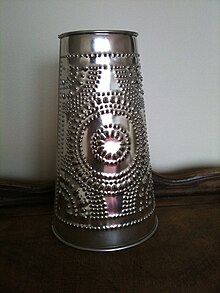

- Many persons still extant, must remember the villainous old coinage of George III.; the tin-like sixpences which added a word to the slang dictionary, and the button-like shillings, of which the image and superscription might have been Caesar's.
- Catherine Grace F. Gore in: Sketches of English character, 1846, p. 13.
- There seems to be a paucity of very ancient objects made entirely of tin — a lack which is sometimes laid at the door of the disintegration of tin through "[[w:Tin pest|tin pest". This is hardly an adequate reason as "tin pest" is difficult enough to initiate.
- Ernest Sydney Hedges in: Tin & its Alloys, Arnold, 1960. P.2.
- Many colonists decorated their homes with objects made out of punched tin. Sometimes they had punched-tin lanterns or candle holders. They also hung punched-tin pictures on their wall.
- Terry Allan Hicks in: Maine, Marshall Cavendish, 2006, p. 33.
- If the white tin is brought in contact with gray tin at ordinary temperatures (below + 20° C), it turns very slowly into gray tin, falling to powder, probably because of the increase in volume (this phenomenon is called the "tin-disease").
- Arnold Frederik Holleman, Hermon Charles Cooper in: A Text-book of Organic Chemistry, Wiley, 1911, p. 275.
- The Little Tin Gods harried their little tin souls.
Seeing he came not from Chetham, jingled no spurs at his heels
Knowing that, nevertheless, was he first on the Government rolls
For the billet of Railway Inspector to little Tin Gods on Wheels.- Rudyard Kipling in: The Collected Verse of Rudyard Kipling, Digireads.com Publishing, 2001, p. 1752.
- There rise her timeless capitals of empires daily born, whose plinths are laid at midnight and whose streets are packed at morn; and here come tired youths and maids that feign to love or sin in tones like rusty razor blades to tunes like smitten tin.
- Rudyard Kipling in:Quotes about Hollywood, Quotations Book.
- Periodic table
There's antimony, arsenic, aluminium, selenium,
And hydrogen and oxygen and,
nitrogen and rhenium,
And nickel, neodymium, neptunium, germanium,
And iron, americium, ruthenium, uranium,
Europium, zirconium, lutetium, vanadium,
And lanthanum and osmium and astatine and radium,
And gold and protactinium and indium and gallium,
And iodine and thorium and thulium and thallium.
There's yttrium, ytterbium, actinium, rubidium,
And boron, gadolinium, niobium, iridium,
And strontium and silicon and silver and samarium,
And bismuth, bromine, lithium, beryllium and barium.
There's holmium and helium and hafnium and erbium,
And phosphorus and francium and fluorine and terbium,
And manganese and mercury, molybdenum, magnesium,
Dysprosium and scandium and cerium and cesium,
And lead, praseodymium and platinum, plutonium,
Palladium, promethium, potassium, polonium,
And tantalum, technetium, titanium, tellurium,
And cadmium and calcium and chromium and curium.
There's sulfur, californium and fermium, berkelium,
And also mendelevium, einsteinium, nobelium,
And argon, krypton, neon, radon, xenon, zinc and rhodium,
And chlorine, cobalt, carbon, copper, tungsten, tin and sodium.
These are the only ones of which the news has come to Harvard,
And there may be many others, but theyhaven't been discovered.- Tom Lehrer in: Karen Dolby Mrs Dolby's Memory Magic: A Comprehensive Compendium of Tools, Tips and Exercises to Help You Remember Everything, Random House, 10-November 2009, p. 118.
- It is inconceivable — and consequently very English! — to have a capital as Simla is entirely of tin roofs, and then the tin roofs monkeying better materials and reducing the whole show to absurdity.
- Edwin Lutyens in: Clayre Percy, Jane Ridley The letters of Edwin Lutyens to his wife Lady Emily, Collins, 1985, p. 245.
M - R
[edit]- They reached for the leather cases to which their shields were pinned. Simultaneously, they pinned the tin to their collars and then walked toward the desk behind which another patrolman was seated.
- Ed McBain in: Cop Hater (1958), Simon and Schuster, 1 December 1999 p. 130.
- When our brother Fire was having his dog's day
Jumping the London streets with millions of tin cans
Clanking at his tail, we heard some shadow say
'Give the dog a bone' - and so we gave him ours;
Night after night we watched his slaver and crunch away
The beams of human life, the tops of topless towers.- Louis MacNeice in: Adolphe Haberer Louis MacNeice 1907-1963, Presses Univ de Bordeaux, 1 January 1986, p. 272.
- The simplest fix for better grilling is to line the inside of your barbecue with tin foil. It dramatically affects how evenly the heat is distributed. That crusty black hibachi or Weber grill is doing your food no favors.
- Nathan Myhrvold on:Nathan Myhrvold, Forbes, 25 February 2011

Solid tin is distinct from tin plate; a receptacle made from this...
- Tin is one of the well-known metals, nearly approaching silver in whiteness and lustre, highly malleable and taking a high polish; used in the manufacture of articles of Tin, in the formation of alloys, as bronze, pewter, etc., and, on account of its resistance to oxidation, for making tin-plate and lining culinary and other iron vessels.
- OED in: tin, n., Oxford English Dictionary.
- Block tin is tin of second quality cast into blocks;
Solid tin is distinct from tin plate; a receptacle made from this.
Grain tin is a very pure tin obtained by fusing stream tin in a blast furnace supplied with charcoal, and breaking it into small pieces.
Phosphor tin is an artificial compound of tin and phosphorus. Stream tin is tin ore washed from the sand or gravel in which it occurs.- OED in:"tin, n."
- A vessel is made of tin, or more usually of tinned iron.
Spec is a vessel in which meat, fish, fruit, etc., is hermetically sealed for preservation
Locally, a small cylindrical drinking vessel or mug with a handle is made of tin.- OED in:"tin, n."

- This conversion is known as tin disease or tin pest. Tin pest was a particular problem in northern Europe in the 18th century as organ pipes made of tin alloy would sometimes be affected during long cold winters.
- Lars Öhrström in: Simon Cotton The last alchemist in Paris, Oxford University Press, Royal Society of Chemistry, rsc.org, 29 April 2014.
- Some unverifiable sources also say that during Napoleon's Russian campaign of 1812, the temperatures became so cold that the tin buttons on the soldiers' uniforms disintegrated over time, contributing to the defeat of the Grande Armée.
- Another version: The urban legend that tin plague caused the disintegration of tin buttons on the trousers of Napoleon’s Grande Armée as it retreated from Moscow in 1812, supposedly causing a collapse of morale (if not of the trousers).
- Lars Öhrström in: "The last alchemist in Paris".
- My first phone was two tin cans tied together with string, and it worked pretty good.
- Dolly Parton in: delight at iPhone application, OK! Online Reporter.
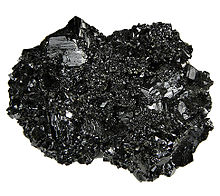
- ...kinds of Tin Ore being extremely variable, and not properly refinable in such small quantities, and the manner of agreeing for or buying the Tin Ore of all sorts being to give Tin bills or promissory notes to the owners thereof, engaging to deliver them at the next coinage so many hundreds of refined Tin for every twenty hundred weight of the ore or Black Tin.
- William Pryce in: Mineralogia Cornubiensis: A Treatise on Minerals, Mines, and Mining, Printed and sold for the author by J. Phillips, 1778, p. 291.
- I have known a blacksmith, a first-rate workman, unaware of the fact that what are called “tin saucepans" are made of tinned plate iron; and there are abundance of tinmen or tin-plate workers who are entirely ignorant of the process by which tin plates are prepared.
- Junius Redivivus in: Edinburgh Magazine, W. Tait, 1834, p. 181.
- This change does not proceed with disintegrating effects until considerably lower temperatures, when the ‘Tin-Pest’, experienced in organ-pipes, during cold winters on the Continent, occurs.
- Sir Harry Ralph Ricardo in:Some Notes and Observations on Petrol and Diesel Engines, Diesel Engine Users Association, 1933, p. 38.
S - Z
[edit]
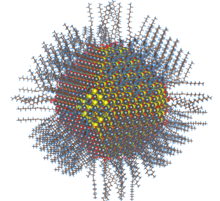
- First clean that; iron and brass well and then tin them before placing them together for soldering...The articles can be tinned by rubbing while hot with resin; then rubbing them over with solder.
- E. Sion in Workshop Receipts Ser 1 (1858), quoted in:tinamou., ned0.org
- He gives the, possibly false, impression, that he has a ‘tin ear’, as his countrymen put it, for many of the popular art-forms he discusses.
- Times Literary Supplement, 24 Jan. 39/2, quoted in Wordwizard, wordwizard.com.
- I'm not ready to say whether it's good or bad, but when a man owns the tin, he has a vested interest in it and there is more pride in what he's doing than when he turns it over to a second party.
- Jay L. Turoff in: Deirdre Carmody Taxi Medallion Cost Pushed To $100,000 By Heavy Demand, The New York Times, 16 December 1985.
- The final tin-dip is useful to remove the marks of the brush, and to make the surface uniformly bright.
- Andrew Ure in: A Dictionary of Arts, Manufactures, and Mines:Containing a Clear Exposition of Their Principles and Practice, Volume 2, D. Appleton & Company, 1844, p. 1259.
- The stanniferous small veins, or thin flat masses, though of small extent, are sometimes very numerous, interposed between certain rocks, parallel to their beds, and are commonly called tin-floors.
- Andrew Ure in: Ure's Dictionary of Arts, Manufactures, and Mines:, Longmans, Green, 1878, p. 1000.
- There are only two ores of tin: the peroxide, tin-stone, or Cassiterite; and tin pyrites, sulphide of tin, or Stannine: the former of which alone has been found in sufficient abundance for metallurgical purposes.
- Andrew Ure in: Ure's Dictionary of Arts, Manufactures, and Mines, Longmans Green, 1878, p. 999.
- In the tin-vat, commonly used for calico-printing, the indigo is reduced by a solution of stannous oxide in caustic potash or soda. The bath is usually mixed with an acid solution of tin, so as to neutralize the alkali and precipitate the indigo-white; the precipitate is then used for printing.
- Henry Watts in : A Dictionary of Chemistry and the Allied Branches of Other Sciences, Volume 3, Longmans, Green, and Company, 1875, p. 252.
- Significance of [research] work is that it is the first attempt to print conductive patterns with the Sn-containing conductive ink... the synthesis of Sn nanoparticles for interconnection materials have been reported… Two factors, cost and low temperature, are the advantages of the Sn-containing conductive ink... By adding the tin nanoparticles to an ink solution, the researchers printed patterns of highly conductive ink from an inkjet printer. As the first demonstration of inkjet printing with tin nanoparticles, the results show that the new technique looks promising for printing various electronic devices that require conductive patterns.
- Lisa Zyga in: Ink with tin nanoparticles could print future circuit boards, phys.org , 12 April 2011.

